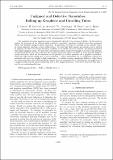Por favor, use este identificador para citar o enlazar a este item:
http://hdl.handle.net/10261/44243COMPARTIR / EXPORTAR:
 SHARE
BASE SHARE
BASE
|
|
| Visualizar otros formatos: MARC | Dublin Core | RDF | ORE | MODS | METS | DIDL | DATACITE | |

| Campo DC | Valor | Lengua/Idioma |
|---|---|---|
| dc.contributor.author | Chico, Leonor | - |
| dc.contributor.author | Santos, Hernán | - |
| dc.contributor.author | Ayuela, Andrés | - |
| dc.contributor.author | Jaskólski, W. | - |
| dc.contributor.author | Pelc, M. | - |
| dc.contributor.author | Brey, Luis | - |
| dc.date.accessioned | 2012-01-13T12:45:17Z | - |
| dc.date.available | 2012-01-13T12:45:17Z | - |
| dc.date.issued | 2010 | - |
| dc.identifier.citation | Acta Physica Polonica A 118(3): 433-441 (2010) | es_ES |
| dc.identifier.issn | 0587-4246 | - |
| dc.identifier.uri | http://hdl.handle.net/10261/44243 | - |
| dc.description | 9 páginas, 11 figuras.-- PACS numbers: 81.05.U-, 73.20.-r, 73.63.Fg, 85.75.-d | es_ES |
| dc.description.abstract | The properties of carbon nano-tubes can be dramatically altered by the presence of defects. In this work we address the properties of two different kinds of defective nano-tubes: junctions of achiral tubes with topological defects and partially unzipped carbon nano-tubes. In particular, we begin by focussing on the interface states in carbon nanotube junctions between achiral tubes. We show that their number and energies can be derived by applying the Born-von Karman boundary condition to an interface between armchair- and zigzag-terminated semi-infinite graphene layers. We show that these interface states, which were thought to be due to the presence of topological defects, are in fact related to the graphene zigzag edge states. Secondly, we study partially unzipped carbon nano-tubes, which can be considered as the junction of a carbon nanotube and a graphene nanoribbon, which has edge features giving rise to novel properties. Carbon nanoribbons act as transparent contacts for nano-tubes and viceversa, yielding a high conductance. At certain energies, nanoribbons behave as valley filters for carbon nano-tubes; This holds considering electron-electron interaction effects. Furthermore, the application of a magnetic field turns the system conducting, with a 100% magnetoresistance. These novel structures may open a way for new carbon-based devices. | es_ES |
| dc.description.sponsorship | This work has been partially supported by the Spanish DGES under grants MAT2006-06242, MAT2006-03741 and FIS2007-66711-C02-C01 and Spanish CSIC under grant PI 200860I048. W.J. and M.P. acknowledge financial support from Polish LFPPI. | es_ES |
| dc.language.iso | eng | es_ES |
| dc.publisher | Polish Academy of Sciences | es_ES |
| dc.relation.isversionof | Publisher's version | - |
| dc.rights | openAccess | es_ES |
| dc.title | Unzipped and defective nanotubes: Rolling up graphene and unrolling tubes | es_ES |
| dc.type | artículo | es_ES |
| dc.description.peerreviewed | Peer reviewed | es_ES |
| dc.relation.publisherversion | http://przyrbwn.icm.edu.pl/APP/ABSTR/118/a118-3-1.html | es_ES |
| dc.identifier.e-issn | 1898-794X | - |
| dc.type.coar | http://purl.org/coar/resource_type/c_6501 | es_ES |
| item.fulltext | With Fulltext | - |
| item.openairecristype | http://purl.org/coar/resource_type/c_18cf | - |
| item.cerifentitytype | Publications | - |
| item.openairetype | artículo | - |
| item.grantfulltext | open | - |
| item.languageiso639-1 | en | - |
| Aparece en las colecciones: | (ICMM) Artículos (CFM) Artículos | |
Ficheros en este ítem:
| Fichero | Descripción | Tamaño | Formato | |
|---|---|---|---|---|
| Unzipped and defectiv.pdf | 1,35 MB | Adobe PDF |  Visualizar/Abrir |
CORE Recommender
Page view(s)
302
checked on 23-abr-2024
Download(s)
184
checked on 23-abr-2024
Google ScholarTM
Check
NOTA: Los ítems de Digital.CSIC están protegidos por copyright, con todos los derechos reservados, a menos que se indique lo contrario.
